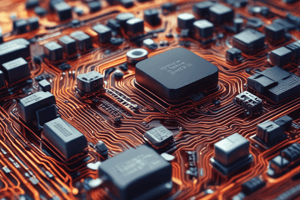Podcast
Questions and Answers
What happens to the brightness of bulbs in a series circuit when an additional identical bulb is added?
What happens to the brightness of bulbs in a series circuit when an additional identical bulb is added?
- The bulbs dim because the total voltage is divided among more bulbs. (correct)
- One bulb receives all the voltage while the others turn off.
- The bulbs become brighter.
- The brightness of the bulbs does not change.
In a parallel circuit, what happens to the voltage across each component?
In a parallel circuit, what happens to the voltage across each component?
- Voltage varies depending on the number of components.
- Every component receives a fraction of the total voltage.
- Every component receives the full amount of voltage from the power source. (correct)
- Every component receives a reduced voltage.
Which factor remains constant for each branch in a parallel circuit regardless of the number of components?
Which factor remains constant for each branch in a parallel circuit regardless of the number of components?
- Electric current in each branch.
- Brightness of identical bulbs.
- Voltage supplied by the battery. (correct)
- Total resistance of the circuit.
What effect does adding a bulb in parallel have on the total current of the circuit?
What effect does adding a bulb in parallel have on the total current of the circuit?
If a single bulb in a series circuit fails, what happens to the remaining bulbs?
If a single bulb in a series circuit fails, what happens to the remaining bulbs?
When removing a bulb from a parallel circuit, what happens to the total resistance of the circuit?
When removing a bulb from a parallel circuit, what happens to the total resistance of the circuit?
In a household breaker box, having multiple switches illustrates which type of circuit?
In a household breaker box, having multiple switches illustrates which type of circuit?
What is a significant disadvantage of series circuits compared to parallel circuits?
What is a significant disadvantage of series circuits compared to parallel circuits?
Which statement correctly describes how current behaves in parallel circuits with identical components?
Which statement correctly describes how current behaves in parallel circuits with identical components?
What happens to the voltage across each bulb in a series circuit when two more identical bulbs are added?
What happens to the voltage across each bulb in a series circuit when two more identical bulbs are added?
What is the primary function of a load in an electric circuit?
What is the primary function of a load in an electric circuit?
Which statement about series circuits is true?
Which statement about series circuits is true?
What type of power source is a battery classified as?
What type of power source is a battery classified as?
What happens in a series circuit if one component is burnt out?
What happens in a series circuit if one component is burnt out?
What role do electric conductors play in an electric circuit?
What role do electric conductors play in an electric circuit?
Which of the following is NOT a characteristic of series circuits?
Which of the following is NOT a characteristic of series circuits?
Which of the following is an example of an electric load?
Which of the following is an example of an electric load?
In a parallel circuit, which characteristic is true?
In a parallel circuit, which characteristic is true?
A primary advantage of series circuits is that they can act as:
A primary advantage of series circuits is that they can act as:
What type of current is provided by home electricity?
What type of current is provided by home electricity?
Flashcards are hidden until you start studying
Study Notes
Electric Circuit Overview
- An electric circuit is a closed loop of electric elements enabling the flow of negative electric charges.
- Essential for circuits is a source of electric charges that provides potential energy to components.
Basic Electrical Circuit Components
- Power Source: Provides electric energy; can be Direct Current (DC) like batteries or Alternating Current (AC) like household electricity.
- Load: Converts electric energy into other forms, such as light (bulbs) or heat; includes resistors, capacitors, and inductors.
- Switch: Opens or closes the circuit; allows current to flow when closed.
- Conductors: Wires with minimal internal resistance that connect loads to the power source.
Types of Electric Circuits
- Circuits can be categorized into Series Circuits and Parallel Circuits based on component arrangements.
Series Circuits
- Components are connected sequentially, resembling a chain.
- Current remains the same through all elements; voltage varies based on component resistance.
- Used as voltage dividers; voltage drop occurs across each element.
- If one component fails (like a burnt bulb), the entire circuit is interrupted.
- Adding components increases total resistance, leading to lower voltage across each component.
- Example: Three identical bulbs in series connected to a 9-volt battery; each receives 2.25 volts with a fourth bulb added.
Real-World Series Circuit Examples
- Household light switches operating multiple bulbs.
- Circuit breakers in residential and workplace settings serve as multiple series circuits.
Parallel Circuits
- Components are connected across the same two voltage points, similar to a ladder.
- Each component receives the full voltage from the power source, a key advantage.
- Current divides between branches, based on each component's resistance.
- Removing a component increases total resistance, decreasing overall current but maintaining voltage for others.
- Example: Three identical bulbs in parallel connected to a 9-volt battery; each bulb receives the full 9 volts.
Real-World Parallel Circuit Examples
- Multicolor Christmas lights; if one bulb fails, others continue to function due to separate circuits.
- Household breaker boxes supply electricity in parallel, allowing independent operation of switches across different circuits.
Studying That Suits You
Use AI to generate personalized quizzes and flashcards to suit your learning preferences.




